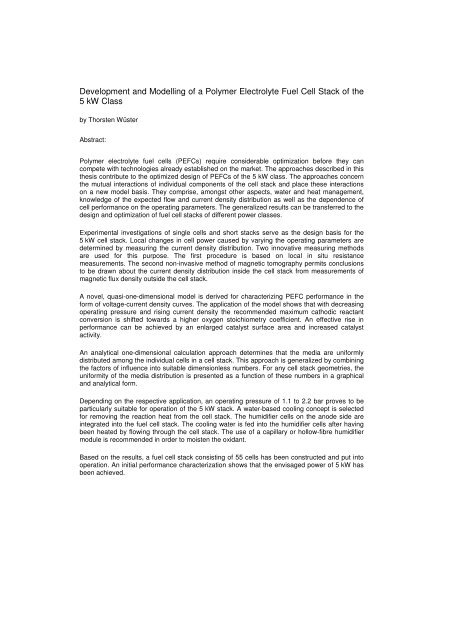View/Open - JUWEL - Forschungszentrum Jülich
View/Open - JUWEL - Forschungszentrum Jülich
View/Open - JUWEL - Forschungszentrum Jülich
Erfolgreiche ePaper selbst erstellen
Machen Sie aus Ihren PDF Publikationen ein blätterbares Flipbook mit unserer einzigartigen Google optimierten e-Paper Software.
Development and Modelling of a Polymer Electrolyte Fuel Cell Stack of the<br />
5 kW Class<br />
by Thorsten Wüster<br />
Abstract:<br />
Polymer electrolyte fuel cells (PEFCs) require considerable optimization before they can<br />
compete with technologies already established on the market. The approaches described in this<br />
thesis contribute to the optimized design of PEFCs of the 5 kW class. The approaches concern<br />
the mutual interactions of individual components of the cell stack and place these interactions<br />
on a new model basis. They comprise, amongst other aspects, water and heat management,<br />
knowledge of the expected flow and current density distribution as well as the dependence of<br />
cell performance on the operating parameters. The generalized results can be transferred to the<br />
design and optimization of fuel cell stacks of different power classes.<br />
Experimental investigations of single cells and short stacks serve as the design basis for the<br />
5 kW cell stack. Local changes in cell power caused by varying the operating parameters are<br />
determined by measuring the current density distribution. Two innovative measuring methods<br />
are used for this purpose. The first procedure is based on local in situ resistance<br />
measurements. The second non-invasive method of magnetic tomography permits conclusions<br />
to be drawn about the current density distribution inside the cell stack from measurements of<br />
magnetic flux density outside the cell stack.<br />
A novel, quasi-one-dimensional model is derived for characterizing PEFC performance in the<br />
form of voltage-current density curves. The application of the model shows that with decreasing<br />
operating pressure and rising current density the recommended maximum cathodic reactant<br />
conversion is shifted towards a higher oxygen stoichiometry coefficient. An effective rise in<br />
performance can be achieved by an enlarged catalyst surface area and increased catalyst<br />
activity.<br />
An analytical one-dimensional calculation approach determines that the media are uniformly<br />
distributed among the individual cells in a cell stack. This approach is generalized by combining<br />
the factors of influence into suitable dimensionless numbers. For any cell stack geometries, the<br />
uniformity of the media distribution is presented as a function of these numbers in a graphical<br />
and analytical form.<br />
Depending on the respective application, an operating pressure of 1.1 to 2.2 bar proves to be<br />
particularly suitable for operation of the 5 kW stack. A water-based cooling concept is selected<br />
for removing the reaction heat from the cell stack. The humidifier cells on the anode side are<br />
integrated into the fuel cell stack. The cooling water is fed into the humidifier cells after having<br />
been heated by flowing through the cell stack. The use of a capillary or hollow-fibre humidifier<br />
module is recommended in order to moisten the oxidant.<br />
Based on the results, a fuel cell stack consisting of 55 cells has been constructed and put into<br />
operation. An initial performance characterization shows that the envisaged power of 5 kW has<br />
been achieved.
















